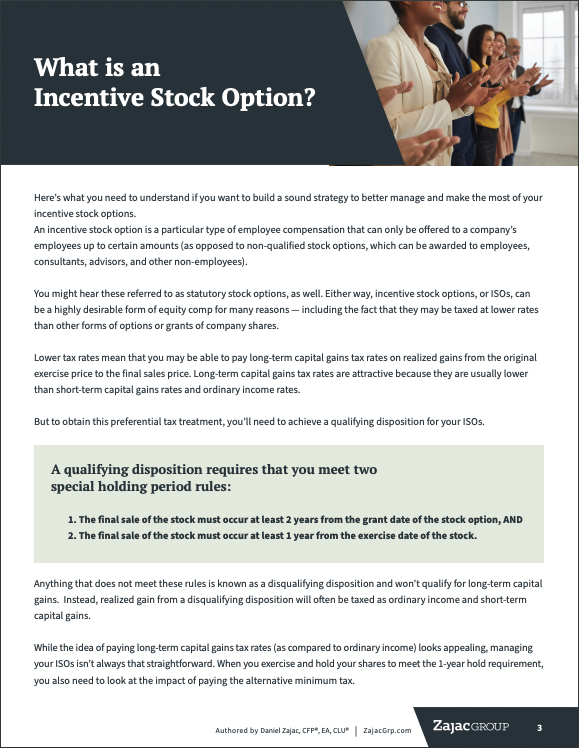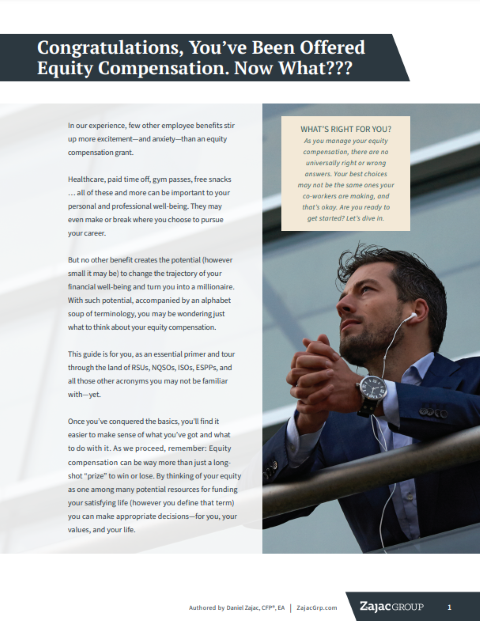If you’re offered incentive stock options (ISOs) as part of your compensation package, you have an exciting opportunity ahead to build significant wealth. The key is to know what, exactly, you’re being given, when your tax bill may be impacted, and how to incorporate your equity comp into your greater financial plan.
To help, we’ve created this basic guide to understanding ISOs and the role they play in your portfolio.
What Are Incentive Stock Options (ISOs)?
ISOs grant you the right, but not the obligation, to purchase shares of company stock at a predetermined price (called the exercise price). ISOs are only made available to employees of the company, meaning contractors, consultants, and board members (who aren’t full-time employees) aren’t eligible to participate.
Because ISOs are purchased at a price set on the grant date, they can become quite valuable for employees when the company stock’s fair market value grows. And compared to non-qualified stock options (NQSOs), ISOs can offer employees the more favorable long-term capital gains tax treatment. That being said, they do come with some strict holding requirements and increase the likelihood you’ll be subject to alternative minimum tax (AMT).
How Do ISOs Work?
When you’re awarded ISOs, your employer gives you an option grant. The day you’re given the option grant is the grant date, and it marks the first official day of your vesting schedule.
The option grant document shares a few key pieces of information:
FREE GUIDE
The Ultimate Guide to Incentive Stock Options
Learn the ins and outs of incentive stock options so you gain a better understanding of what you have.
- The number of shares you’re eligible to purchase
- Your vesting schedule (the dates when you’ll be able to purchase shares)
- The exercise price (the price you’ll pay per share once they’ve fully vested)
- Expiration date (the last day you’ll be eligible to exercise your options before they expire)
If you multiply the exercise price by the number of options granted, this will tell you how much you can expect to pay to exercise all your options. Calculating this number ahead of time can help you start to prepare for your future potential tax liability.
How Does an ISO Vesting Schedule Work?
Very rarely will an employee be given access to their stock options immediately upon receiving the grant. Instead, they’ll be subject to a vesting schedule. The date that your ISOs vest is often the first day you can act on your right to exercise the option.
Your vesting schedule will typically be either (or a combination of) a cliff vesting or graded vesting schedule.
With cliff vesting, all the option shares become vested at once. If you’re on a four-year cliff vesting schedule, for example, 100% of your options will vest after the four year period has passed.
With a graded vesting schedule, a percentage of your shares will vest at intervals throughout the vesting period. For example, 25% of your options may vest after the first year in a four-year vesting period, with another 25% vesting the following year, and so on. Alternatively, once 25% of the options vest after the first year, vesting may then occur at more frequent intervals over the remainder of the vesting schedule, such as monthly or quarterly. Graded vesting is the more common type of vesting schedule, as it enables employees to accrue ownership of options gradually over time.
Exercising Your Options
Generally speaking, you can exercise your options as soon as they vest—but you don’t have to. If you choose not to exercise, your ISOs simply remain “vested and unexercised.”
In terms of when and how to exercise your vested options, it’s up to you and your advisor to make a decision based on a few important factors:
Do you anticipate the share price to continue rising? Remember, the fair market value of your options isn’t solely based on company performance. It can also be impacted by broader market movements and economic factors.
While your exercise price will remain the same (regardless of FMV), you’ll want to consider if this is an investment worth keeping in your portfolio—or if you anticipate future stock values pulling down your portfolio’s equity performance. It’s impossible to predict future performance with 100% certainty, but you and your advisor may be able to analyze historical performance and future growth or revenue projections to make such a determination.
Do you need the funds right away? If you were to exercise and sell your options, you’d have a sizable lump sum of cash. What would you spend the money on? It’s important to consider your equity compensation as a building block within your greater financial plan, and that means being intentional with how you spend, reinvest, or save the proceeds from exercising and selling your options.
For example, you may choose to reinvest into more diversified assets, pay off debt, buy your dream home, fund a child’s college savings, pursue a new business venture, or fulfill a different lifelong goal.
Do you feel your portfolio is too concentrated in employer stock? If so, exercising, selling, and transitioning the profits to other more diversified investments could help protect your portfolio long-term.
Do you understand the tax and cash flow implications of an exercise and hold? We’ll dive deeper into the tax treatment of ISOs below, but knowing what is (and isn’t) a taxable event is critical to proactive planning for your ISOs.
How to Exercise Your ISOs
When you exercise your ISOs, you’re purchasing shares of company stock at a discounted rate—assuming the fair market value is higher than the exercise price.
Let’s say you have 10,000 shares of vested ISOs, which you’re able to purchase for $10 a share. In order to exercise your options, you’ll need $100,000 to cover the exercise price—keeping in mind a tax bill could be coming as well (more on this in a minute).
There are three common ways to do this:
- Exercise with cash: You have the option to pull from your savings or other liquid assets and cover the cost of exercising with cash.
- Cashless exercise or sell-to-cover: If the FMV of your options is higher than the exercise price, you can choose to sell a portion of the shares in order to cover the cost of exercising.
- Same-day sale: You can exercise your options and immediately sell all shares for a same-day sale.
If you work for a private company that offers ISOs, your alternatives may be limited. Private company employees may not have a liquid market to sell their shares in, since shares aren’t publicly traded. When that’s the case, your only viable option may be to exercise with cash.
Do ISOs Expire?
ISOs do have an expiration date, which is the last possible day you can exercise vested options. ISOs typically expire 10 years after the grant date, though that timeline may shorten depending on your employment status.
If you’re terminated from the company, you will often be subject to a 90-day post-termination exercise window. If you do not exercise your vested ISOs within such window, they will automatically convert to NQSOs (and lose their more favorable tax treatment).
A Note on Early Exercise
Some companies may allow for an “early exercise” of ISOs. If you’re given this option, you can exercise your ISOs before they’re vested. Doing so will start the clock on holding period requirements and attempting to mitigate AMT, but this comes with additional risk and other considerations you’ll need to discuss with your advisor.
How Are ISOs Taxed?
ISOs are not subject to tax when they’re granted or when they vest. They are also not subject to ordinary income tax at exercise. However, the spread between the exercise price and FMV at exercise may be subject to AMT. Once the exercised options are sold, any increase in value over the exercise price are taxable—though if certain criteria are met, they may receive long-term capital gains tax treatment.
To recap:
- Grant: No tax impact
- Vest: No tax impact
- Exercise: No ordinary income tax impact, but potential AMT on the spread
- Sell: Profit is taxed as either ordinary income or capital gains (or loss), depending on the holding period
Speaking of selling, when you sell shares of exercised ISOs, it can lead to one of two outcomes: either a qualified disposition or a disqualified disposition.
Learn more about ISOs and taxes here.
What Is a Qualified Disposition?
In the event your final sale price is higher than the exercise price, you’ll earn a profit or capital gain. If the sale price is less, you’ll report it as a capital loss (which can help offset some tax liability from other investment profits or ordinary income, up to annual limits). To receive the favorable long-term capital gains tax treatment, the sale will need to count as a qualified disposition.
Two criteria must be met for a qualified sale:
- The sale occurs at least two years after the option grant date, and
- the sale occurs at least one year after the exercise date.
If you meet the criteria above for a qualified disposition, profits will be taxed at the long-term capital gains tax rate, which caps out at 20%. In addition, you may be eligible for AMT credit in the same year you sell qualified ISOs. More specifically, you can use the difference between regular capital gains and AMT capital gains as an adjustment when calculating AMT. In years when you sell qualified ISOs, you may be able to accelerate your AMT credits.
Learn more about qualifying dispositions here.
What Are Disqualifying Dispositions?
If you do not meet the criteria for a qualifying disposition, it is considered a disqualifying disposition. Profits from a disqualified sale are generally taxed at your ordinary income tax rate, but the details can get complicated.
AMT
As we mentioned, you won’t owe ordinary income tax when exercising ISOs, but you may need to report the spread at exercise when figuring alternative minimum tax (AMT).
ISOs increase the likelihood you’ll owe alternative minimum tax (AMT), particularly if you exercise and hold your incentive stock options with the goal of a qualified dispostion. If you exercise and hold beyond the end of the calendar year, you’ll need to adjust your AMT calculation for the bargain element—the spread between your ISO strike price and the FMV at exercise.
If you exercise and sell your ISOs prior to the end of the year, however, no adjustment is required for figuring AMT (assuming no replacement shares are purchased).
We won’t get into the weeds with AMT now since you can learn more about ISOs and AMT here.
Can I Take My ISOs When I Leave My Job?
What you do with your ISOs post-termination will depend on their status:
Unvested options: If you leave your company (or are terminated) before the vesting schedule is complete, you will lose the ability to exercise your unvested options. They’ll instead be forfeited and get thrown back into the company options pool.
Vested and exercised ISOs: If your vested options have already been exercised, the shares are yours to do with as you please (hold or sell). That won’t change once you leave your job.
Vested and unexcercised ISOs: If you have vested ISOs, you’ll need to review the terms of your grant agreement to determine what happens next. Oftentimes, companies offer a 90-day post-termination window in which you need to exercise your vested options, or lose them. Some companies will extend this post-termination exercise window for employees, particularly if there’s a special circumstance surrounding their termination. In either case, remember, the IRS imposes a 90-day post-termination rule that says ISOs will convert to NQSOs after 90 days if unexercised.
Have More Questions About Your ISOs?
Though it may not feel like it, we’ve really just skimmed the surface when it comes to ISO planning and strategizing. With quite a few factors at play here, you may find it helpful to speak with a professional who understands the nuances, challenges, and valuable opportunities in equity compensation planning.
We invite you to reach out and give us a call if you’d like to discuss your ISOs in more detail.










0 Comments